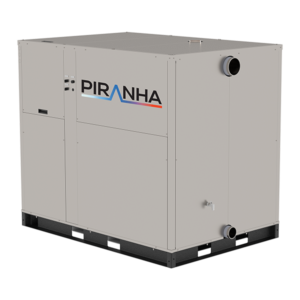SVL News
How To Recover Wastewater Heat with SHARC Energy
In This Coffee Break We Learn How to Tap Into a Massive Energy Source Flowing Right Under Our Feet
What is the value of wastewater heat?
The US Dept of Energy estimates that Americans discard 350 billion kWh of heat energy annually. That’s equal to the output of nearly 88 Hoover Dams sent down the drain by dishwashers, washing machines, and hot showers.
Wastewater maintains the same temperature year-round, with minimal changes throughout the seasons. The average person uses 30 gallons of hot water per day at 120 °F. Commercial and industrial wastewater temperatures can reach 140 °F or higher. An untapped flow of energy is continuously leaving our buildings for the sewer.
What kinds of solutions capture this energy?
 SHARC Energy currently offers heat reclamation systems in two setups:
SHARC Energy currently offers heat reclamation systems in two setups:
The Piranha is a self-contained heat pump designed for direct expansion heat exchange to recover thermal energy for domestic hot water. Wastewater is pumped from a holding tank into the unit containing a braised plate heat exchanger.
The potable and black water remain separate throughout, and the heat is transferred to the domestic hot water supply. With a COP of 3.5 or higher, the Piranha outperforms an electric water heater (COP 1).
A variation, Piranha HC, has a second connection for the building’s cooling loop. It features the same heat output as the Piranha with an added cooling capacity. By extracting energy from the cooling loop, it can achieve a COP of 7 or higher.
Their namesake SHARC system is larger and intended for a campus of buildings or a municipal sewer line. SHARC is a passive wastewater separator and filter that accesses thermal energy by temporarily removing solids from wastewater.
The filtered wastewater passes through a heat exchanger, which is connected to heat pumps for domestic hot water, heating and cooling, and even geo-loop conditioning and offset. The resource it provides is exponential, capturing megawatts of energy for low kilowatts of energy input.
Where can we apply these technologies?
The Piranha applies to any space with hot water needs, including hospitals, microbreweries, hospitality, commercial laundry, 50- to 350-unit apartment buildings, student housing, senior living, or community housing.
SHARC requires a minimum flow rate of 100 gallons per minute, so it’s best suited to operations like commercial food production, large breweries, dairies and cheesemaking, and 350-plus unit apartments and condos.
SHARC also has excellent potential in so-called “energy districts.” For example, in 2022, New York State passed the Utility Thermal Energy and Jobs Act that allows utilities to develop, operate, and maintain thermal energy networks. Several other municipalities may follow suit.
These energy districts could, for example, power an entire town using a mix of geothermal arrays, sewer energy, and SHARC technology. It would create an ambient energy loop through a large part of the city and allow heat pumps in buildings on that loop to pull and push energy for heating, cooling, and domestic hot water.
What other benefits does this tech bring to a building?
SHARC is one method of high-efficiency electrification, a way to hedge against future carbon taxes and gain immediate rebates from energy utilities.
Reducing or removing cooling towers can free up your building’s rooftop space for green space or solar capacity. This technology moves equipment to a mechanical room for quieter operation, ease of service, and extended lifespan out of the elements.
Hydronic heat also takes up less space than traditional air ducts, increasing the amount of usable space in a building design. Current and future building codes may also mandate some degree of electrification.
SHARC systems can help offset a property’s thermal load while increasing the building’s net asset value and operating income.
Sign Up For Our Next Coffee Break:
Ask our SVL sales engineers for an invitation and stay updated on the latest information in HVAC.









































